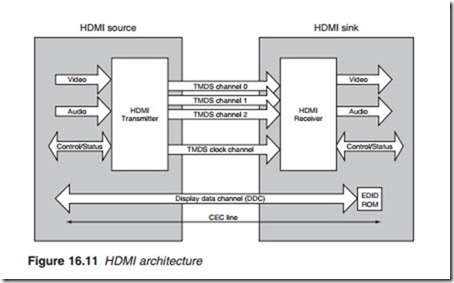High-definition multimedia interface
The high-definition multimedia interface, HDMI is provided for transmit- ting digital television audiovisual signals from DVD players, set-top boxes and other audiovisual sources to television sets, projectors and other video displays. It is designed to carry all standard and high-definition consumer video formats as well as high-quality multi-channel audio data. The standard provides content protection to prevent illegal copying. HDMI can also carry control and status information in both directions.
The HDMI protocol supports a number of video formats including:
● 1280 X 720p @ 59.94/60 Hz
● 1920 X 1080i @ 59.94/60 Hz
● 720 X 480p @ 59.94/60 Hz
● 1280 X 720p @ 50 Hz
● 1920 X 1080i @ 50 Hz
● 720 X 576p @ 50 Hz
Architecture of HDMI
HDMI system consists of a source, also known as encoder or transmitter (TX) and a Sink, also known as a decoder or receiver (RX). The data is sent on three pairs of wires carrying a differential TMDS signals, hence the name TMDS channels. A fourth channel carries the clock as shown in Figure 16.11. In addition, a VESA display data channel (DDC) and a consumer electronics control (CEC) lines are available as well as a hot plug signal. The DDC is used for configuration and status exchange between a single Source and a single Sink. The DDC is used by the Source to read the Sink’s Enhanced Extended Display Identification Data (E-EDID) stored in a ROM chip in order to discover the Sink’s configuration and/or capabilities. DDC specifications are similar to the serial control bus I²C bus specifica- tions outlined in Appendix 2.
The optional CEC is a low-speed bus that works at 400 bps. The proto- col provides high-level control functions between all of the various audio- visual products in a user’s environment such as one-touch play, one-touch record and menu control.
The hot plug signal detection pin informs the source when it can start to read the E-EDID. A voltage between 2.0 and 5.3 V connected to this pin means that a receiver is connected, and that it could start to read the E-EDID.
